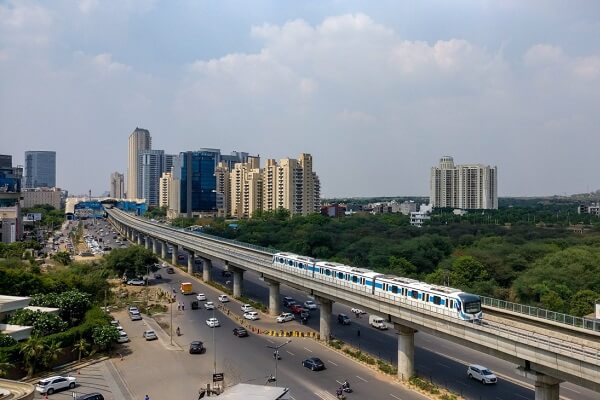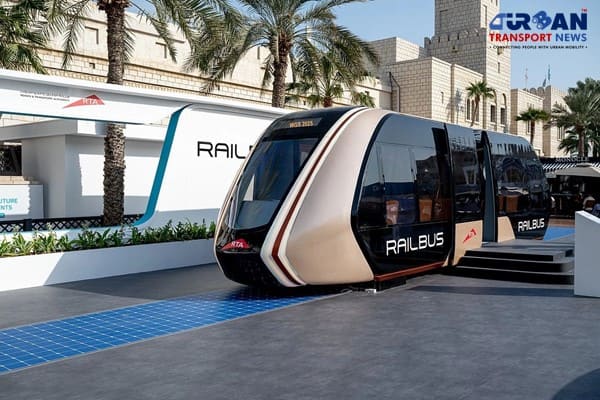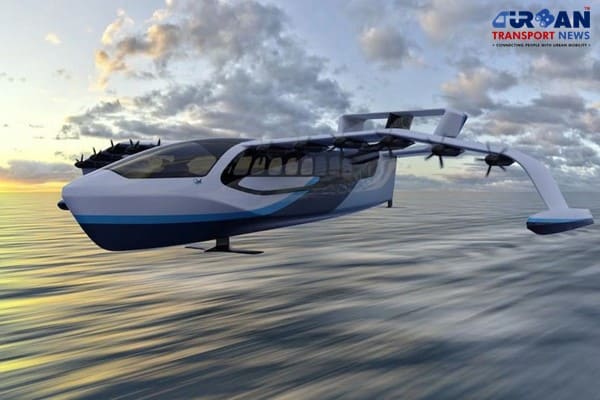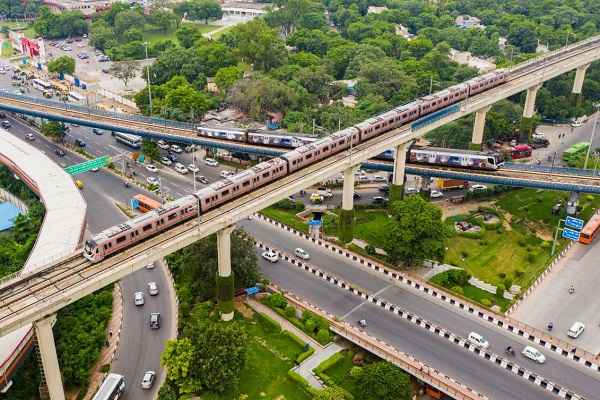 Delhi unveils ambitious Urban Mobility Vision: Luxury Metro Coaches, New Tunnels and Pod Taxi
Delhi unveils ambitious Urban Mobility Vision: Luxury Metro Coaches, New Tunnels and Pod Taxi Qatar approves Saudi Rail Link Agreement, Accelerating Gulf Railway Vision 2030
Qatar approves Saudi Rail Link Agreement, Accelerating Gulf Railway Vision 2030 UP Govt plans to introduce Water Metro services in Ayodhya, Varanasi & Prayagraj
UP Govt plans to introduce Water Metro services in Ayodhya, Varanasi & Prayagraj India’s First Urban Ropeway begins Trial Run in Varanasi, Set to carry 1 Lakh passengers daily
India’s First Urban Ropeway begins Trial Run in Varanasi, Set to carry 1 Lakh passengers daily India and Bhutan to Build First-Ever Rail Link: ₹4,033 Cr Project to Boost Regional Connectivity
India and Bhutan to Build First-Ever Rail Link: ₹4,033 Cr Project to Boost Regional Connectivity Patna to launch Eco-Friendly Water Metro; Trial Run soon between Digha and Kangan Ghats
Patna to launch Eco-Friendly Water Metro; Trial Run soon between Digha and Kangan Ghats Air India Group set to launch Flights Operations from Navi Mumbai International Airport
Air India Group set to launch Flights Operations from Navi Mumbai International Airport Chennai to launch 25-Year Mobility Plan with Unified QR Ticketing and One-App Transit System
Chennai to launch 25-Year Mobility Plan with Unified QR Ticketing and One-App Transit System Kochi Metro bags ₹4.4 crore contract to prepare DPR for Mumbai Water Metro Proejct
Kochi Metro bags ₹4.4 crore contract to prepare DPR for Mumbai Water Metro Proejct Navi Mumbai International Airport set for September launch; IndiGo and Akasa Air to lead Operations
Navi Mumbai International Airport set for September launch; IndiGo and Akasa Air to lead Operations
Mass Rapid Transit System (MRTS) - A sustainable mode of Transport System

Mass Rapid Transit is defined for the purposes of the review as public transportation services, which involve a substantial degree of collectivization or combining individual trips into shared trunk linkages. It comprises those modes based on a specific fixed track or exclusive and separated usage of a potentially common user road track. It thus includes separated or largely separated busways but excludes bus lanes and other forms of priority for buses in mixed traffic. The nature and significance of secondary modes of access and egress to the trunk facility are considered part of the overall system. The review considers urban settlements of different sizes and is not confined to the experience of megacities.
The core requirement of mass transit in developing cities is that it carries large numbers of passengers, rapidly. In the absence of large subsidies, this requires both low cost (hence low fares) and speed in operation. The speed is critical to securing its impact, hence the term mass rapid transit is used in this review.
So, the MRTS is a sustainable transport system.
The article is full of attempts to categorize these modes. They may be categorized in terms of:
- Their technology (bus or rail-based), influences aspects of service quality, capacity, the ability to segment the market, and cost.
- Right-of-way exclusivity determines speed and reliability.
- Grade separation allows new alignments, and strongly influences the cost.
- Guidance may offer new alignment possibilities and other impacts.
- Operational possibilities may offer different service qualities and flexibility.
I have reviewed the MRT systems actually operating in developing cities and have categorized them by technology and degree of segregation which broadly translate into the level of service, capacity and cost. Four generic forms of mass transit currently exist. These are defined for use in this study as follows:
- Busways- These are unless otherwise stated at-grade with horizontal protection from other traffic, often with priority over other traffic at junctions, which are signalized.
- Light Rail Transit (LRT) – this is unless otherwise stated at grade, with similar horizontal protection.
- Metros – these are fully segregated, usually elevated or underground. It is the segregation that is critical to providing a rapid service, and the technology that allows a high mass ridership to be carried.
- Suburban rail – these services are physically part of a larger rail network, usually at grade and fully segregated by means of controlled level crossings.
I have limited the extent of my study to only two modes viz., Busways and Metros and have been discussed in the literature part.
Need of MRTS
- Unprecedented Growth of personal vehicles- the urban area population of a metropolitan city increased by 1.9 times in India from 1981 to 2001 but the number of motor vehicles increased by 7.75 times during this tenure.
- Growing Traffic Congestion- The people of the urban area felt various traffic problems like accidents, congestion, and crowding on the road, this is because of the increasing population (travelers) and older transport which is not efficient.
- Time saving-As we know that the rail metro has a faster speed and dedicated corridor as well, so definitely it takes less travel time than others
- It can be calculated from the formula using different parameters like a daily run of vehicles, speed in congested traffic and speed in decongested traffic.
As per thought, there are mainly two types of mass rapid transit systems based on path, i.e. rail and bus. The bus rapid transit system is the bus-based mass rapid transit system. Further rail-based MRTS categorized into a few types manually operated and fully automated, then manually operated is classified as Underground (Metro Rail), On Surface (Suburb Train) and Elevated (Monorail), Than Underground or metro rail which may be run on the surface also can be divided into three types:-
- High Capacity Rail Transit System
- Medium Capacity Rail Transit System
- Light Rail Transit System
History of MRTS
London underground is the first metro rail or rail-based rapid transit system which starts in January 1863 between Paddington to Farringdon. This system had a steam engine and a wooden carriage. Although its idea came in 1830 but granted permission to start the work in 1854. It had a great success Declared in two days only because it carriage 38000 passengers on the opening.
Then in 1875 first British metro started with the Company, “The metropolitan railway of Constantinople to the Galata Pera”.
In the USA, the oldest subway tunnel is in Boston (1897). New York City has the largest four-track line of 14.5 km in length in the world.
Madrid metro was opened on 17 Oct 1919, which is now one of the largest metro systems in the world.
In 1924, the Barcelona metro starts. Moscow is credited for the first metro-rail in USSR, which opened in1935. Moscow metro is now the busiest metro system in the world. After that automated (without ATO) metro rails were started.
In between Toronto, Montreal and Brazil starts the metro in 1954, 1966 and 1974 respectively. In Asia, Tokyo is the first city for opening the metro (1927), and Osaka is the second (1933). Later on Beijing (1969), Hongkong (1974), Singapore, famous for its heavy rail system (1987), Taiwan(1996), Iran (1999), UAE (2009), and Saudi Arabia (2011) were noticed for using the metro rail.
MRTS in India
First metro rail in Kolkata metro(1984), then Delhi (2002) and Gurugram (2013). After the success of these metros now many more cities starts to work on building the MRTS system, like Mumbai, Hyderabad, Bangaluru, Chennai, Kochi, Jaipur, Hyderabad, Nagpur, Pune, Ahmedabad, Kanpur etc.
Metro systems are more reliable, comfortable and safer than road-based systems and it reduces congestion on the roads. However, systems planned in India show that cost overrunning and underutilization of capacity. Methodology and arguments used to justify these systems need careful analysis. A high-capacity system does not necessarily generate high demand. Estimation of passenger demand for transit services should consider the complete journey of commuters including access time. As we saw the mass rapid transit system from Farringdon to Delhi was continuously appreciated. Similarly, BRTS all over the world is appreciated. It minimizes travel time, GHG emissions, traffic accidents, and fuel consumption.
The benefits of MRTS can be categorized like-
- It requires 1/5th energy per passenger km compared to road-based transport system.
- It causes less noise, no air pollution and eco-friendly transport system.
- It occupies no road space if underground and only about 2.60 meters width of the road if elevated.
- It reduces journey time.
- It is a cost-effective mass transport system.
- It is reducing traffic transport problems.
(This article was co-authored by Er. Parveen Singh, Professor, RIMT Sonipat, and Ishfaq Majid Wani, M. Tech. Student)







